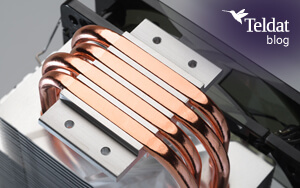 Heat pipes transfer heat on electronic devices & industrial applications, using the heat transition principle, to transfer to heat sinks within a cooling system. Heat pipes have clear advantages over other heat dissipation methods.
Heat pipes transfer heat on electronic devices & industrial applications, using the heat transition principle, to transfer to heat sinks within a cooling system. Heat pipes have clear advantages over other heat dissipation methods.
What are heat pipes?
Heat pipes are passive heat-transfer devices used to efficiently move heat from one location to another. They are commonly employed in electronic devices (such as laptops, desktop computers, smartphones, LED lights and Wi-Fi routers), as well as in industrial applications (such as cooling systems for power plants and aerospace applications). In electronic devices, heat pipes are used to transport the heat generated by a component to a heat sink. They are often used in laptops (where placing a large fan directly above the processor is not always possible) and in high-performance heat sinks for servers and desktops (where they transfer heat from the CPU to a much larger radiator than the one that could be placed above).
Key information on heat pipes:
Basic principle: Heat pipes operate on the principle of phase transition to transfer heat. They consist of a sealed tube containing a small amount of working fluid, typically water, ethanol, or a fluorinated hydrocarbon. Heat pipes transfer heat from one hot end to a cold one via phase transition.
Operation: When the hot end of the heat pipe absorbs heat, the working fluid inside the heat pipe vaporizes. The vapor then travels to the cold end of the heat pipe and condenses back into a liquid due to the lower temperature. The condensed liquid then returns to the hot end through capillary action or gravity and the cycle repeats.
Design: Heat pipes come in various shapes and sizes, depending on the application. They can be straight or bent into different shapes to fit the available space. In addition, they can be fitted into complex heat pipe assemblies to further enhance heat transfer capabilities.
Advantages of heat pipes
Heat pipes offer several advantages over other heat dissipation methods, especially in applications where high heat transfer efficiency is needed. Some of the main advantages include:
Heat transfer efficiency: Heat pipes are highly efficient thanks to their ability to transport heat via the evaporation and condensation of the internal fluid. This allows for rapid heat dissipation from the heat source to the heat sink. This high efficiency makes them ideal for transferring heat over longer distances or between irregular surfaces.
Improved thermal conductivity: Heat pipes are typically made of highly conductive materials, such as copper or aluminum. This improves heat transfer along the heat pipe and to the heat sink, resulting in more effective cooling.
Even heat distribution: Heat pipes can evenly distribute heat along their length, which helps avoid hot spots and improves cooling efficiency over the entire surface of the heat sink.
Compact and lightweight design: Heat pipes are relatively thin and light (compared to other heat dissipation methods). This makes them ideal for applications where space and weight are limited, such as mobile devices and laptops.
Quiet operation: Since heat pipes do not require fans to operate, they can help reduce the noise generated by the cooling system (as opposed to solutions that rely solely on fans).
Reliability and extended life: Heat pipes are passive devices that have no moving parts. This makes them sturdier than other cooling systems based on fans or other mechanical components and can help extend their useful life.
Heat pipe applications
Consumer electronics and Wi-Fi routers: Laptops, smartphones, game consoles, etc., use heat pipes for thermal management.
LED lighting: Heat pipes are used to dissipate heat generated by LED bulbs to maintain optimum operating temperatures.
HVAC systems: Heat pipes are used in heating, ventilation, and air-conditioning systems for energy-efficient heat recovery.
Aerospace and automotive industries: Heat pipes are used in thermal control systems for spacecrafts, satellites, and high-performance vehicles.
In summary, heat pipes play a crucial role in thermal management in various industries, offering efficient and reliable heat transfer solutions.
Sources:
https://es.wikipedia.org/wiki/Tubo_termosif%C3%B3n_bif%C3%A1sico
https://www.heat-pipes.com/index.php?sectionid=6&gad_source=1&gclid=Cj0KCQjwiYOxBhC5ARIsAIvdH51O8d5iCQNHCAl1v_xs725TNQBKlRdcbfXWZZMgMdXwUHPYRAJzW7AaAlB2EALw_wcB
https://hardzone.es/2018/01/27/como-son-como-funcionan-disipadores-con-heat-pipes/


























